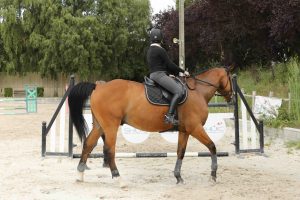Detection of low-grade hind limb lameness can be challenging. How can locomotion data assist even the most experienced equine veterinarians in their expertise?
Insights from Dr. Jürgen Bodamer, veterinary surgeon specializing in equine sports medicine & pre-purchase exams at West Coast Equine - Sport Medicine Clinic in Ireland.

Analysis of hind limb lameness
Locating the source of lameness is a recurring challenge for veterinarians. Resorting to nerve blocks then becomes a significant aid in isolating the affected area.
On hind limbs, the challenge can be even more difficult. The weight distribution, anatomical specifics and compensatory phenomena are among the factors that complicate the analysis of hind limb asymmetries, as confirmed by Dr. Bodamer.
“I think hind limb lameness detection can be more challenging because of the anatomical makeup of the hindlimb and because there can be so many different compensating movement patterns when pathology occurs in the hind limb. After all, the hind limb with the sacral/pelvic area combined with the lower back are the “engine” of the equine athlete.”
Detecting sacroiliac pain, sharing experience from Dr. Jürgen Bodamer (Vet.Surg, Dr Med.Vet, CertEqQportsMed, MRCVS)
"I recently was presented with the case of a 6-year-old Irish Sport Horse gelding, trained for eventing. The gelding experienced issues in show jumping competitions.
He was reluctant to comply on the right hand lead and on right-hand circles. He bucked his rider off during a competition, when too much pressure was placed on the right hind limb. The manifestations of pain were amplified when the horse was ridden. The rider also reported that the farrier noticed discomfort, when shoeing the gelding on the right hind hoof.
On the day I conducted my clinical examination, the gelding was moving well. The stride length was slightly shorter on the right hind limb.
In my opinion, the horse presented at that time with a very slight asymmetry of less than a grade of 1/5. More weight was falling on the right hind limb. The stride was shortened on the right hind.
Based on my observations, the clinical examination revealed that the origin was soreness on the right hind upper and not that the horse wasn't able to put pressure on the left hind. It was confirmed by the load distribution data collected by the Tendiboots™.
It was also nice to see the cross pattern translating onto the front legs with the Tendiboots™ data.

"Palpation of the right hindlimb and croup revealed nothing abnormal. Contrary to my expectations, no projectional pain was palpated on the right side gluteal musculature.
Another observation was that the tail carriage was "lifeless", but straight during trot, and the gelding showed signs of discomfort when I flexed the right hind limb. Right hind limb flexion was slightly positive. On right-hand circles, the lameness was more pronounced (2/5) with restricted (shortened) movement of the right hind limb.
All of these factors led me to suspect a right-sided downward fixation of the sacrum, which I corrected. Following this manipulation, I repeated the recordings with the Tendiboots™ to observe the data's evolution. The result was striking!”

Downward fixation of the sacrum correction
To correct this type of locomotion disorder, osteopathic manipulations are performed by equine veterinary professionals, as explained by Jürgen:
"Downward fixation of the sacrum can be corrected with downward tail movements. I don’t use this technique, I think it is dangerous for everyone involved.

Instead, I prefer to use a forward/upward thrust of the limb of the affected side.
Following this manipulation, the stride of the right hind limb was back to what I would expect for this horse.
The owner contacted me again some time later and reported that the horse had significantly improved and that its locomotion and comfort had returned to normal.”
The sacroiliac dysfunction
Issues related to the sacroiliac joint are very common in sport horses. They can be due to traumas such as falls, for example, or excessive athletic efforts. In equine veterinary medicine, a sacroiliac subluxation occurs when the sacroiliac joint, which connects the ilium (part of the pelvis) to the sacrum (bone of the spine), becomes misaligned or partially displaced.
In this type of dysfunction, cases can be found where the sacrum becomes locked in a downward position (as in the case of this blog post), causing pain during propulsion and manipulation of the hind limbs. In these cases, the horse may limp, be stiff in the hind limbs, have difficulty engaging forward, and exhibit significant underperformance.
Treatment for this type of pain can be done through manual manipulation. The veterinarian aims to correct the position of the sacrum and restore its normal, athletic function.

This article was produced in collaboration with Dr. Jürgen Bodamer, ISELP member, who exclusively practices in equine veterinary medicine. Specialising in equine surgery and equine sports medicine.
Find more information on his website : https://www.west-coast-equine.ie




